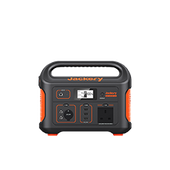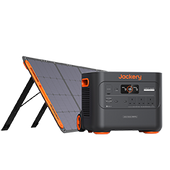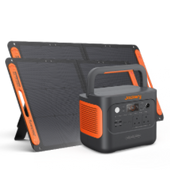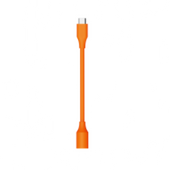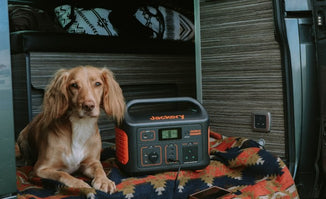The best option for power backup in today's world is solar energy, as it is the most environmentally friendly and cost-effective method of energy production. The Jackery solar power generators are perfect for in-house power backups as they are noise-free, safe, and easy to operate.
What Are The Power Outages?
When we are discussing what is the reason the power is out, it is also important to understand what can be called a power outage technically. A power outage is an electric power failure in a certain area or a part of the power grid. It can be as small to affect a few houses or widespread enough to cut off a whole town.
What Is The Reason Power Is Out?
What causes power cuts? There are numerous factors at play. Power outages can result from human error, faults in transmission lines, system overloads, and accidents. Nonetheless, the predominant cause of power disruptions remains weather-related incidents.
It's noteworthy that climate change plays a significant role in the increasing frequency of power outages in the UK. Older generations might recount experiences of power cuts as rare occurrences, happening perhaps only once or twice in their lifetimes. However, in recent years, even complete blackouts have become more commonplace. Research indicates that power outages have surged significantly since the early 2000s, with a marked increase associated with climate-related events. The UK's infrastructure, like many others worldwide, is grappling with the challenges posed by more extreme weather conditions, underscoring the need for enhanced resilience and adaptation strategies.
What Are The Types of Power Outages?
We can classify the power outages depending on why the power is out and how widespread the effect is.
Brownout
Brownout is not a complete power outage; instead, in this situation, the voltage in the system decreases to a deficient level. Hence, the lights are dim, and the equipment might not work because of low voltage.
Blackout
A blackout is a complete power failure in an extended area, and it can be caused by any damage in the power grid anywhere between the power station and power lines. This can be a brief event of a few seconds or minutes, and sometimes, it can take days to recover, depending on the complexity of the error.
Permanent Fault
A permanent fault is usually an isolated fault that affects a smaller area, and it is usually fixed very quickly. Most of the time, it is a fault in the mechanism or a minor glitch.
Rolling Blackouts
Rolling blackouts are planned power outages to fix faults and unstable grid or electrical infrastructure. These are easier to deal with as they are part of regular maintenance, and you are informed earlier.
How to Prepare for A Power Outage?
Even if you are still determining what is the reason the power is out, it is always better to prepare beforehand. As we already discussed, these power failures are becoming more frequent, so planning today is the way to go.
- Always have some emergency light source at home. An alternate light source in the most frequently used room keeps your folks safe from falls and accidents. You will also keep extra batteries, and periodically checking the lights for working is also recommended.
- Keeping connected to your local channels or social media also helps you to know what is the reason the power is out and how long it will take to resume. In case of bad weather, the news is always important.
- Keep your freezer cold for a long by not opening it again. If you don't open it, it can maintain its temperature for 24 to 48 hours.
- Invest in a backup generator. Though it can be a gas or propane generator, the most sustainable and low-maintenance option is a solar generator. They are almost noise-free, have no fuel cost, and can be plugged in in a minute. The Jackery solar generators are industry-leading highly efficient solar generators. The Jackery solar panels have the highest solar energy conversion of about 24-25%. The positive point of these generators is that they are portable and can be used for outdoor adventures. Also, they have an advanced battery management system and protection against overcharging, overheating, and other safety angles.
How to determine the size of a solar generator
The size of the generator depends on your family size, the weather, and if you want to use the generator for outages only or regularly. Following a brief run-through about determining the size of a solar generator.
- Find the wattage of your appliance, including both starting and running watts. The wattage is usually written on the product label. We have also listed the wattages in the following table for your convenience.
- Sometimes, power requirements are listed in volts and amperes. You can use the following formula to calculate the running watts from volts and amperes.
Volts (V) x Amps (A) = Watts (W)
- Add the running watts of all your appliances, and now add the highest starting watts from the list to this number. This sum is your required solar generator output.
Starting and Running Watts of Common Household Appliances
|
Appliances |
Starting Watts |
Running Watts |
|
Flashlight |
0 |
5W |
|
Refrigerator/Freezer |
2200 |
700 |
|
Light Bulb |
0 |
60-75 |
|
Toaster |
0 |
900 |
|
Space Heater |
0 |
2000 |
|
Laptop |
0 |
50-300 |
|
20” Box Fan |
350 |
200 |
|
Dishwasher |
1800 |
1300 |
|
Blender |
800 |
300 |
|
Clothing Iron |
0 |
1500 |
- Have a backup plan about not using or limiting dishwashers, electric grills, heating, and air conditioning to save energy even if you have a generator.
How To Protect Yourself During A Power Outage
An unexpected power outage can become a dangerous situation with a bit of carelessness. Always aim for your safety and your equipment's protection first. Following are a few guidelines to follow.
- Switch off all electrical appliances, especially the ones that can become a safety hazard if left unattended. Electric cooking, grilling, and heating equipment lie in this category.
- Always leave at least one prominent light turned on so that you know when power resumes.
- Also, check with your neighbors if they are also experiencing an outage to find out what is the reason the power is out. If they have power, your trip switch might be the cause.
- Save on your phone charging and flashlight batteries, as the power may not resume long, and you want to be connected to the world.
- Report the power outage to the network operator and concerned authorities.
Jackery Solar Generators: Your Home Backup Power
Solar generators combine a solar panel, a charge controller, a battery, and an inverter into a box to convert solar energy into a usable electrical current. The process of solar generator goes like this;
- Solar panels collect energy from the sun and also convert it to Direct Current power.
- The Charge Controller receives this D.C. power and regulates and stabilizes it before storage. This component ensures a suitable amount of current is sent to the battery and prevents it from overcharging.
- Battery saves this electricity, and you can power your required appliances even when the sun is not shining.
- The Inverter converts the D.C. current stored in the battery to A.C. power so that your devices or appliances can consume it.
Jackery Solar Generator 1000 Plus

Jackery Solar Generator 1000 Plus is a big powerhouse that you can use to run most of your appliances. It has a massive 1260Wh capacity and a whopping 2000W power output. It comes with a Smart App Control to simplify management for everyone. Since it is weather resistant and can work up to -20°C /-4°F, it is perfect for very cold areas.
Customer Review:
"I have been researching solar generators for the past six months. Though I shortlisted Jackery very early in my process, what generator from the list to choose was a difficult decision. As soon as the company launched 1000 Plus, I was probably among the first few customers. I love it so far. I am incredibly impressed by its fast charging and almost negligible noise levels. "
Jackery Solar Generator 2000 Plus

The Solar Generator 2000 Plus has an expandable capacity, so you can add battery packs and solar panels to get a gigantic 24 kWh output. Also, it is rapid to charge and takes only two hours to charge from 0 to complete using solar panels. Its ChargeShield Technology is a unique feature, a variable-speed charging algorithm that boosts battery life by 50%. Also, it can be charged very fast using solar panels and AC outlets.
Customer Review:
"I always look for expandability and a long lifespan in everything I buy. Your tools and equipment must be able to grow with you. The expandable capacity of the 2000 Plus was the main clicking point for me. "
|
Product |
Solar Generator 1000 Plus |
Solar Generator 2000 Plus |
|
Capacity |
1264Wh |
2042.8Wh |
|
Cycle Life |
4000 cycles to 70%+ capacity |
4000 cycles to 70%+ capacity |
|
Dimension |
Length: 14in Width: 10.24in Height: 11.14in |
Length: 14in Width: 10.24in Height: 11.14in |
|
Recharging Methods |
Solar Panel Wall outlet Carport |
Solar Panel Wall outlet Carport |
|
Output Ports |
2 x USB-C Output 100W Max, 5V⎓3A, 9V⎓3A, 12V⎓3A, 15V⎓3A, 20V⎓5A 2 x AC Output 230V~ 50Hz 8.7A Max 3 x USB-A Output 18W Max, 5-6V⎓3A, 6-9V⎓2A, 9-12V⎓1.5A |
2 x USB-A Output, 18W Max 2 x USB-C Output, 100W Max 3 x AC Output, 230V~ 50Hz 13A Max |
Power Outage FAQs
1) What size of solar generator do I need when power outages?
The solar generator you need during blackouts or power outages should have at least 1800 to 2000 watts output capacity to run the most commonly used appliances in your house. However, for a more accurate estimate, you need a calculation of the running watts of all your appliances, and you also need to know the starting watts of your devices. Your required solar generator size exceeds this calculation. We have also discussed it in part 5 of this article.
Another critical point is the working time of batteries. Since there is always a loss of power during the work. So, for the Jackery solar generator working hours estimation, we take this 15% loss of power into account. So the formula goes like this;
Working time = Capacity Wh * 0.85 / operating wattage of your device.
2) How long does a power outage last?
It depends on what is the reason the power is out. The trivial errors can be fixed quickly, and power outages may last just a few seconds. However, some power outages can last days or even weeks.
3) How do you report and check power outages in your area?
The most basic way to report and check power outages in your area is to check with your utility company. You can find their contact information on your electricity bill, or you can search online for their customer service phone number.
Some utility companies also give you an app or website to contact them and to get recent updates. Some companies may have online tools on their website that allow you to check the status of power outages in your area.
If the outage is widespread, encompassing many areas, you might need to report a power outage to your local authorities, such as your city or town hall.
Final Thoughts
Power outages have become very common now. Naturally, with every incident, people think what is the reason the power is out as it also helps them to know the expected time to resume, and they can plan accordingly. The most common reasons are usually weather, system failure, and maintenance. We have discussed the best alternative power arrangements, safety during power outages, and how to find the required size of your backup generator.







